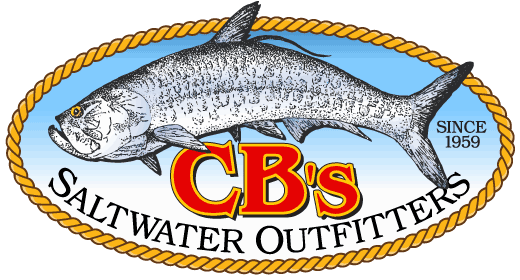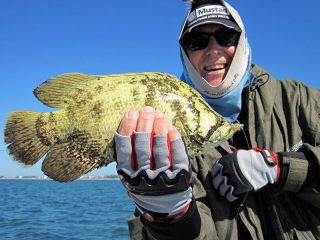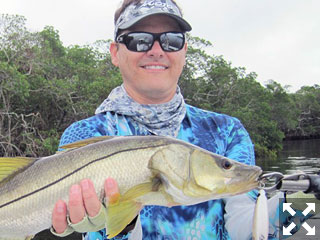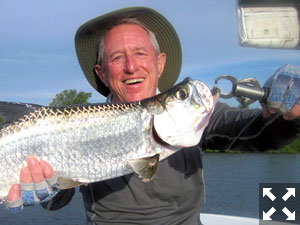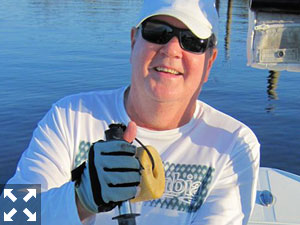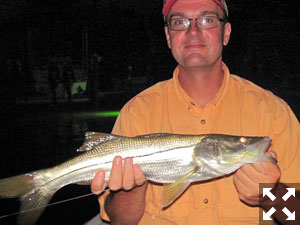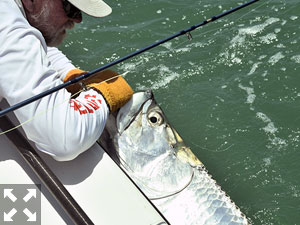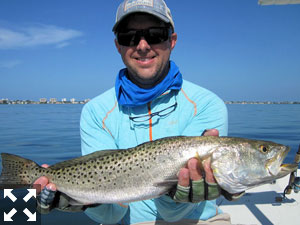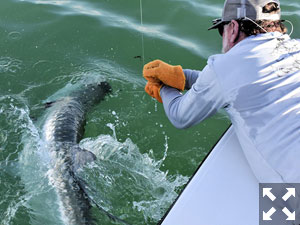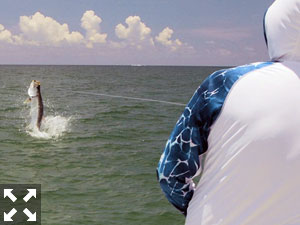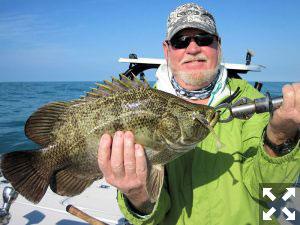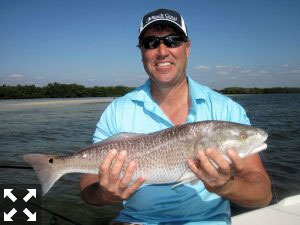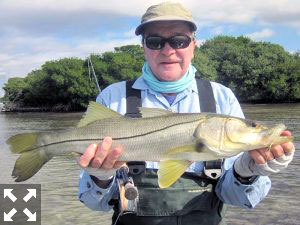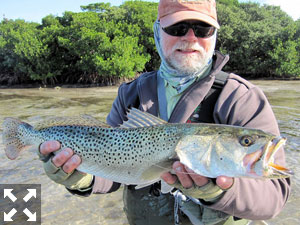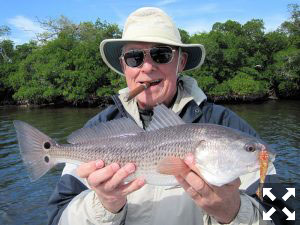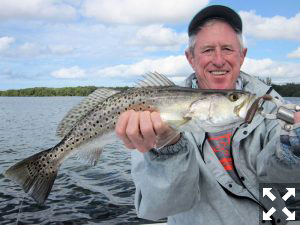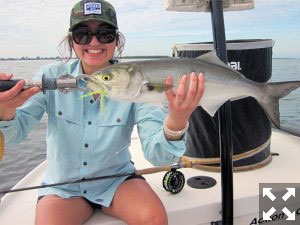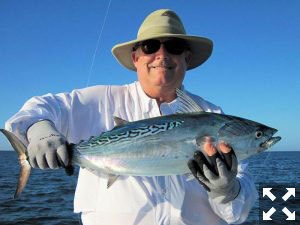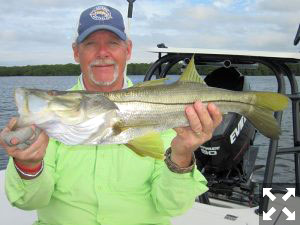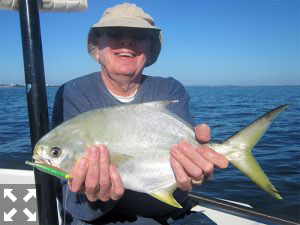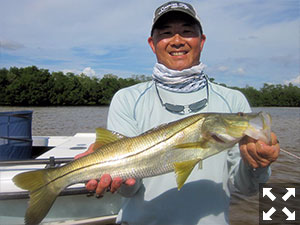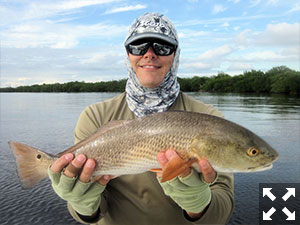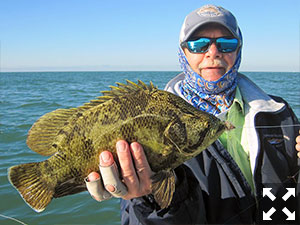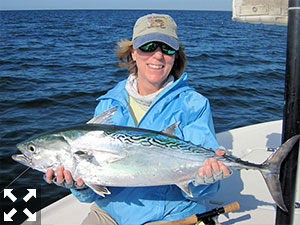Capt. Rick Grassett’s Monthly Forecast for Oct. 2019
Fishing should turn on this month. Schools of reds will begin to break up and scatter on shallow flats. There should also be good action with snook and big trout in shallow water. Snook will gorge themselves at night around lighted docks in the ICW. There should also be good action in the coastal gulf with Spanish mackerel, false albacore (little tunny), tripletail and cobia. You might also still find tarpon anywhere from upper Charlotte Harbor and Tampa Bay to along the beaches.
Snook, reds and spotted seatrout are closed to harvest on the west coast of Florida. The Florida FWC has enacted a temporary modification of regulations for reds and snook, in the areas affected by last year’s red tide. The area extends from Pasco County, south to Gordon Pass in Collier County.
Reds, snook and spotted seatrout (of any size) are catch and release only in that zone until May 31, 2020. Full details including exact boundaries can be found at www.myfwc.com. Since these species are now closed, use tackle heavy enough to catch and release them quickly.
Snook will move from passes and the surf as water temperature cools and days get shorter. They will stage around docks and bridges in the ICW and along sand bars, potholes and along mangrove shorelines. They may blow up on top water plugs or fly poppers in shallow water early or late in the day. CAL jigs with shad tails and jerk worms or DOA Shrimp should work well around docks and bridges and on shallow flats. The 4” CAL shad tail should work very well on the flats since larger baits will be prevalent there. I like larger flies, like Lefty’s Deceiver and my Grassett Flats Bunny, for snook on the flats for the same reason. Fly anglers should also score with small white flies or Gurglers around lighted docks and bridge fenders. Fish peak tidal flows for the best action.
Tarpon will still be an option this month. I find them in upper Charlotte Harbor this time of year. Look for them feeding in ladyfish schools or rolling in deep water to find them. DOA Baitbusters and Swimming Mullet are my top producing lures for large tarpon. Fly anglers should score with many of the same flies that work for sight casting to them along the beaches. I use 12-wt fly tackle with a floating or clear intermediate sink tip line for large tarpon. You’ll also find juvenile tarpon from 10 to 30-pounds in many creeks and canals of the Peace or Myakka Rivers. Spin anglers should score with DOA Shrimp or TerrorEyz on snook tackle. Fly anglers can handle the smaller fish on 8 or 9-wt fly rods with fast sinking fly lines and a scaled down version of any fly that large tarpon will eat. I’ve also found tarpon feeding in the coastal gulf in October. They are usually scattered over a broad area, feeding in bait schools. This “reverse migration” may only last for a few days but it can be really good!
Big schools of reds that are more common in August and September will break up into smaller schools, singles and doubles by the end of the month. As water cools and baitfish school up, reds will feed in shallow water. I like to pole my flats skiff to hunt for reds in shallow water. Focus on baitfish or mullet schools to find reds. CAL jigs with shad tails, including the 4” CAL shad tail and DOA Baitbusters are some of my favorite lures to locate reds with. If the tide is very low, weedless-rigged CAL shad tails or DOA Shrimp rigged backwards will work well in the thick turtle grass. Once I’ve located fish, wading is often the best way to approach them when fly fishing. I like a long leader (12’) on a floating fly line with a lightly weighted fly with a weed guard, like my Grassett Flats Minnow. When you have good sunlight, you may be able to sight fish them on light colored bottom, like sandbars or potholes.
You’ll also find big trout in many of the same areas in shallow water. I would approach locating big trout the same way as reds. Focus on baitfish or mullet schools to find them and use the same lures and flies to catch them. Some of the best action that I’ve experienced with big trout was at first light with big trout feeding in baitfish schools in very shallow water.
You’ll find trout of all sizes on deep grass flats. Wherever there are small trout, there may be a few “gators” around since big trout will eat small ones. Mixed with trout there should also be blues, Spanish mackerel or pompano. In addition to focusing on bait and birds, I like to drift and cast ahead of the drift with CAL jigs and shad tails or DOA Deadly Combos or a lightly weighted fly on a sink tip fly line to find fish. When toothy fish are around add 6”of heavy fluorocarbon (60-lb) or wire to prevent cut offs.
You may find tripletail or cobia around buoys, crab trap floats or channel markers in inside waters or the coastal gulf. A DOA Shrimp or CAL jig with a shad tail will work well for tripletail. Fly anglers should score with lightly weighted flies with a weed guard. A DOA Baitbuster or 4” CAL shad on 20 to 30-pound class spinning tackle or a wide profile tarpon fly on a minimum of 9-weight fly tackle will get the job done with cobia.
Look for Spanish and king mackerel or false albacore in the coastal gulf. I look for diving terns or “breaking” fish to find them. Once you’ve located feeding fish, a CAL jig with a shad tail or jerk worm or a size specific top water plug will work well for spin anglers. Fly anglers should score with olive, chartreuse or white flies, poppers and Crease flies. You’ll need wire or heavy fluorocarbon when mackerel are in the mix. You may also find a few kings around the edges of feeding frenzies. I don’t usually target kings, but I will catch a few when fishing breaking mackerel or albies. You can also look for tripletail or cobia around crab trap floats, buoys or channel markers while searching for mackerel or albies in the coastal gulf.
October is one of my favorite months. It’s nice to do something different, so I like to fish the coastal gulf for mackerel, false albacore, tripletail and cobia when conditions are good. There should also be good action on shallow flats with reds, trout and snook or tarpon of all sizes in upper Charlotte Harbor. Night snook fishing in the ICW heats up as the water cools down. Our natural resources are under constant pressure from red tides fueled by agricultural, industrial and residential runoff and discharges, freezes, increasing fishing pressure and habitat loss and degradation, please limit your kill, don’t kill your limit!
Capt. Rick Grassett’s Monthly Forecast for Sept. 2019
September is one of my favorite months. Reds should be schooling on shallow grass flats and you also might find big trout there at first light. Baitfish along beaches will attract Spanish mackerel, false albacore (little tunny), sharks, tarpon and more. You should find snook around docks and bridges in the ICW. There should also be tarpon around bridges at night and in areas of Tampa Bay and Charlotte Harbor. Juvenile tarpon from 10 to 30-pounds should be a good option in creeks and canals.
Tarpon will still be a good option this month. There may still be a few singles, doubles and small schools in the coastal gulf and if you’ve got the patience to wait them out it can be good. Many have moved to inside waters this month, so you’ll find them around bridges, over deep grass flats or deeper areas. When tarpon move into these areas, they are in a feeding mode. After a long migration and with their spawning duties completed, they need to rest and eat to restore themselves. Ladyfish will feed in glass minnow schools and tarpon will gorge themselves on ladyfish.
I have also seen tarpon, “ball” glass minnows into tight schools, and eat them by the bucket full! DOA Baitbusters, TerrorEyz and DOA Shrimp are my favorite tarpon lures this time of year. Fly anglers should score with wide profile patterns, such as Lefty’s Deceiver or EP flies. Small flies, like my Grassett Snook Minnow, tied on a 1/0 or 2/0 hook, are another good choice for tarpon that are feeding on glass minnows.
Snook, reds and spotted seatrout are closed to harvest on the west coast of Florida. The Florida FWC has enacted a temporary modification of regulations for reds and snook, in the areas affected by last year’s red tide. The area extends from Pasco County, south to Gordon Pass in Collier County. Reds, snook and spotted seatrout (of any size) are catch and release only in that zone until May 31, 2020. Full details including exact boundaries can be found at www.myfwc.com. Since these species are now closed, use tackle heavy enough to catch and release them quickly.
You should find snook this month around docks and bridges close to passes. They will also start making their move towards shallow flats where you might find them staging along sand bars or in potholes. Surface walking top water plugs or fly popper and Gurglers may draw some big strikes in shallow water early in the day. I often fish lighted docks and bridges for snook before dawn before moving to the flats after daylight. CAL jigs with shad tails and jerk worms, DOA Shrimp or small white flies, like my Grassett Snook Minnow, should all work well. The same lures and flies that work at night will be good for fishing the surf, too.
Reds are usually in large schools in September. You may find them in shallow water when the tide is high or along the edges of flats when the tide is low. Look for wakes, some as big as boat wakes, or “pushes” to locate them. If it is calm, a school of reds may look like a nervous patch of water or if there’s a ripple on the surface, the school may appear as a slick patch of water. Once you’ve located them, try to get in front of them and work around the edges of the school to avoid spooking the whole school. DOA PT-7 top water baits, shallow running DOA Baitbusters and CAL 4” shad tails should work well for spin anglers. Fly anglers should score with fly poppers, Gurglers and wide profile baitfish fly patterns. I like to be as quiet as possible in shallow water, using a push pole to move my boat. Electric trolling motors can be used sparingly, but varying the speed or running at faster speeds will often spook a school. It is great to find a big school of reds but remember, if you spook 1 fish you may spook the whole school. Running an outboard may make fish show themselves, but in the long run it will make them harder to catch. I sometimes also find big jacks and blues mixed with schools of big reds in shallow water. Not a bad problem!
Trout fishing should also be good this month. Look for big trout in skinny water in many of the same places that you find reds this month. They will be most active in low light, either first thing in the morning or at dusk, particularly if we’ve had an afternoon shower. Cloud cover in the afternoon will also reduce heating of shallow flats, which usually makes fish more active. The same lures and flies that you use for reds will work well for big trout in shallow water
You may also find trout mixed with blues, pompano, Spanish mackerel, flounder and more on deep grass flats of Sarasota Bay. I like to drift and cast ahead of my drift with DOA Deadly Combos or CAL jigs with shad tails or jerk worms. Fly anglers should do well with an Ultra Hair Clouser fly fished on a clear intermediate sink tip.
In addition to making a series of drifts to find fish, focus on bait schools, breaking fish or diving birds to find fish. You may find tripletail on buoys, crab trap floats or channel markers in Sarasota Bay this month. A DOA shrimp, CAL jig or a lightly weighted fly with a weed guard should get the job done.
You should also find tripletail along with cobia, false albacore (little tunny), king and Spanish mackerel in the coastal gulf this month. Look for surface activity to find the mackerel and albies and cast small white flies or CAL jigs with shad tails to them. I don’t usually target kings but will occasionally catch one around the edges of a feeding frenzy. Look for feeding frenzies that begin with ladyfish feeding in glass minnow schools and may end with everything else, including sharks or tarpon, joining the fray. Remember to “match the hatch” to be successful. You’ll need to add wire to your leader when toothy fish are around.
While you are looking for mackerel and albies in the coastal gulf, you can look for tripletail and cobia. However since stone crab traps haven’t hit the water yet this season, there are less places for them to be. In addition to abandoned crab trap floats, check channel markers, buoys and any floating debris. Artificial reefs are another good area to check. A DOA Baitbuster, 4” CAL shad tail or a wide profile fly should be good choices for cobia. Most tarpon flies also work well for cobia.
There are lots of options this month, but the key is usually to fish early or late for the best chance at success. An early start for snook or tarpon around lighted docks or bridges and then on to the flats for reds, trout and more is a good plan. There should also be good action in the coastal gulf for a variety of species. I usually tarpon fish as long as I can, wherever I find them! Our natural resources are under constant pressure from red tides fueled by agricultural, industrial and residential runoff and discharges, freezes, increasing fishing pressure and habitat loss and degradation, please limit your kill, don’t kill your limit!
Capt. Rick Grassett’s Monthly Forecast for August 2019
Tarpon will move into estuaries this month. You may also find juvenile tarpon in creeks, canals and turning basins. Reds should be schooling on shallow flats and big trout will prowl the same waters at dawn. Also look for trout on deep grass flats mixed with blues, pompano, Spanish mackerel and more. Catch and release snook fishing should be good around lighted docks at night or in the surf. Look for false albacore (little tunny) to possibly show up in the coastal gulf later in the month.
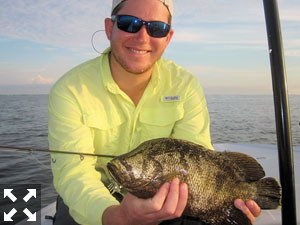
Raul Ortiz had good action catching and releasing tripletail fishing Sarasota Bay in a previous August.
Tarpon addicts will still be able to get their fix this month. You should still find a few tarpon in the coastal gulf early in the month. Drifting live baits or casting flies, DOA Baitbusters, DOA Shrimp and DOA 4” CAL shad tails should all work. As tarpon thin out along beaches, they will move to inside waters where you may find them schooling around bridges or rolling on deep grass flats. They will also feed in schools of ladyfish that are feeding on the surface. You should also find juvenile tarpon from 10 to 30-pounds in creeks, canals, and turning basins.
Your snook tackle will work fine for smaller tarpon although you’ll need a leader of 40 to 60-pounds to keep them from going through it. Fly anglers should score with 8 or 9-weight fly rods, floating or sink tip lines and scaled-down tarpon flies.
Snook, reds and spotted seatrout are closed to harvest on the west coast of Florida. The Florida FWC has enacted a temporary modification of regulations for reds and snook, in the areas affected by last year’s red tide. The area extends from Pasco County, south to Gordon Pass in Collier County. Reds, snook and spotted seatrout (of any size) are catch and release only in that zone until May 31, 2020. Full details including exact boundaries can be found at ‘www.myfwc.com Since these species are now closed, use tackle heavy enough to catch and release them quickly.
You’ll find snook around lighted docks and bridges in the ICW and in the surf. Small white flies, like my Grassett Snook Minnow, DOA Shrimp or CAL jigs with shad tails and jerk worms should all work well. The same lures and flies will work at night and in the surf, although you should be observant of what size baits are in those areas.
Reds should school up this month, although their numbers have been thinner for the past couple of years. You should find them on shallow flats where they’ll be easier to find when the tide is low. Look for “nervous” water when it is slick calm or a slick patch of water when there is a ripple on the water. They may push a wake that looks like a boat wake. I try to be as quiet as possible in shallow water, poling to locate them.
Once you’ve located a school of reds, try to get ahead of them to intercept them, much like tarpon fishing. If you work around the edges of the school, you may be able to catch a few of them before they spook. We often also find big jacks, blues and other predators in the mix along with reds. Topwater plugs and fly poppers or Gurglers may draw some big bites. The DOA PT-7 topwater bait and 4” CAL shad tail should both work well on schooling reds.
Trout fishing should be good this month. You may find a big trout in skinny water at first light. Focus on mullet or bait schools to find them. Topwater plugs, fly poppers or Gurglers should be very effective at that time of day. Handle big trout over 20” gently, since they are usually females that may be full of roe. I like the same areas for big trout that I like for reds.
After it gets bright and starts to warm up, drop out to deeper grass flats (4’ to 8’) for trout and more. I like to drift and cast ahead of my drift with CAL jigs and shad tails or jerk worms or an Ultra Hair Clouser fly fished on a sink tip fly line. I make a series of drifts to locate fish and then shorten the drift or anchor depending on conditions. Ladyfish may feed in glass minnow schools and if they stay up long enough, it will attract trout, blues, mackerel, tarpon or sharks.
Wide profile plastic baits or flies fished slowly around the edges of breaking fish will help keep ladyfish off your lure or fly and give you a chance to catch a tarpon. When blues, Spanish mackerel or sharks are in the mix, add 6” of wire or heavy fluorocarbon. Also look for tripletail around crab trap floats, buoys or channel markers in inshore waters this month. A CAL shad tail or DOA shrimp rigged weedless or my Grassett Flats Minnow fly with a weed guard should get the job done.
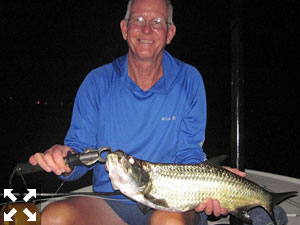
Bob Delano, from GA, with a juvenile tarpon caught and released in a previous August with Capt. Rick.
You might find false albacore (little tunny) or Spanish mackerel in the coastal gulf this month. Look for baitfish to find them. The Tampa Bay ship channel is often one of the first areas where I find them this time of year. Small white flies, like my Grassett Snook Minnow, poppers or Crease flies should all work well. Spin anglers should score with CAL jigs and shad tails. You’ll need to add wire or heavy fluorocarbon when toothy fish are around.
Even though it is one of the hottest months of the year, there are lots of options this month. I usually tarpon fish as long as I can either in the coastal gulf or in inside waters. An early start for snook or tarpon around lighted docks or bridges and then on the flats for reds, trout and more is a good option.
Our natural resources are under constant pressure from red tides fueled by agricultural, industrial and residential runoff, freezes, increasing fishing pressure and habitat loss and degradation, please limit your kill, don’t kill your limit!
Capt. Rick Grassett’s Monthly Forecast for July 2019
Tarpon will still be a good option this month. Shallow water action for reds and big trout will be best early and late in the day. Some of the best action will be with trout, blues, pompano and more on deep grass flats. Catch and release snook fishing in the ICW at night or in the surf should also be good options.
Tarpon fishing should be good in the coastal gulf this month. Large schools of tarpon will dwindle in size and numbers to singles, doubles and small schools of post-spawn fish during July. I usually find tarpon to be aggressive in July, with spawning completed and after a long migration, they usually feed aggressively.
I also find them to be more curious this time of the year often swinging closer to check out the sound of a landing bait, lure or fly.
Spin anglers will do best by setting up in travel lanes and drifting live baits under floats while staying ready to sight cast to fish that may pop up with no notice. The DOA Baitbuster is my “go-to” lure for tarpon. The DOA Swimming Mullet, 4” Shrimp and CAL 4” swimbait are also good choices depending on the situation. I like the Owner Beast hook with the CAL swimbait. It is easier to penetrate a hard tarpon mouth with a single sharp hook rather than a treble hook.
This is my favorite time to fly fish for tarpon. The tactics are the same as earlier in the season, anchoring or staking out on travel routes, although fish are in a better mood. Unlike the large tarpon schools that we see around full and new moon phases in June, July fish are usually aggressive. Large schools of tarpon are impressive, but if you spook the lead fish you will spook all of them.
Tarpon will thin out towards the end of the month as they begin to move to inside waters of Sarasota Bay, Tampa Bay, and Charlotte Harbor. They move into these areas to rest and feed following spawning. They can be targeted in these areas with flies, a variety of DOA lures or live bait. Also, look for tarpon feeding in schools of “breaking” ladyfish in these areas.
Snook, reds and spotted seatrout are closed to harvest on the west coast of Florida. The Florida FWC has enacted a temporary modification of regulations for reds and snook, in the areas affected by last year’s red tide. The area extends from Pasco County, south to Gordon Pass in Collier County. Reds, snook and spotted seatrout (of any size) are catch and release only in that zone until May 31, 2020. Full details including exact boundaries can be found at www.myfwc.com. Since these species are now closed, use tackle heavy enough to catch and release them quickly.
Catch and release snook fishing will be a good option this month. With very warm water this time of year, it is important to use tackle heavy enough to land them quickly. Spin anglers should do well fishing lighted docks and bridges in the ICW with CAL jigs with shad tails or jerk worms or DOA shrimp. Fly anglers should do well with clear intermediate sink tip lines and wide profile flies, such as Lefty’s Deceiver or EP flies, since larger baitfish may be more predominant. Docks and bridges close to passes should be the best ones. You’ll also find snook in the surf, where you can walk along the beach and sight cast to them in shallow water. The same lures and flies that work at night usually also work in the surf, although be observant of the size baits that are present in the area you are fishing so you can “match the hatch”.
You’ll find reds very active in shallow water this month. With plentiful baitfish and higher tides, they’ll spend more time feeding over shallow grass flats. Look for them along the edges of bars or in potholes when the tide is low or along mangrove shorelines and around oyster bars when the tide is high. You’ll also find big trout in many of the same areas where you find reds, but the bite for big trout is usually best early or late in the day. Surface walking topwater plugs or fly poppers and Gurglers may draw some big explosions! Casting CAL jigs with shad tails or jerk worms ahead of your boat is a good way to locate reds.
I like to drift deep grass flats and cast ahead of my drift with CAL jigs and shad tails or jerk worms, DOA Deadly Combos or Ultra Hair Clouser flies tied on long shank hooks on sink tip fly lines to find trout. A drift anchor will slow your drift to a more manageable speed if it’s windy. Look for birds or baitfish on the surface to find fish. You may find Spanish mackerel, blues, pompano and more mixed with trout on deep grass flats. Flats close to passes or on points that get good tidal flow are usually productive.
In addition to tarpon, you might find false albacore (little tunny), tripletail or cobia in the coastal gulf this month. Look for albies feeding on the surface. You might even find a stray king mackerel in the mix around feeding frenzies. I have seen large schools of albies “blitz” the beach while tarpon fishing this time of year. They are usually feeding on larger baits, such as threadfins or pilchards, so flies and lures should be sized accordingly. You might even find cobia swimming with tarpon or cruising bars in shallow water along the beach. You can use your tarpon fly or spin tackle for cobia, but a medium spinning outfit or an 8 to 9-weight fly rod will be better suited for mackerel and albies. I also occasionally run into tripletail this time of year, either around a crab trap buoy, navigational marker or floating debris.
There are lots of options this month, late-season tarpon, snook in the surf or at night or fishing skinny water for reds or big trout. Tarpon fishing is best when sweat is pouring down your back, but you’ll want to fish early in the day in shallow water. Our natural resources are under constant pressure from red tides fueled by agricultural, industrial and residential runoff, freezes, increasing fishing pressure and habitat loss and degradation, please limit your kill, don’t kill your limit!
Capt. Rick Grassett’s Monthly Forecast for June 2019
Tarpon should be plentiful in the coastal gulf this month as big schools of fish migrate along our beaches. Also look for cobia, tripletail and false albacore (little tunny) in the coastal gulf. Catch and release snook fishing should also be good in and around passes and in the surf. Fishing should also be good on deep grass flats for a variety of species.
Tarpon fishing should be strong this month as schools of fish increase in size and numbers. They will head offshore to spawn close to new and full moons. Set up in travel lanes along the beach at first light in the morning and cast live crabs, baitfish, DOA Baitbusters, and Swimming Mullet to them. I travel well offshore along the beach in the morning to avoid disturbing schools of tarpon that may be traveling close to the beach.
Once you’ve reached the area you intend to fish, ease into the beach with an electric trolling motor and set up in your spot. You can anchor or drift, depending on conditions. Give other anglers several hundred yards of space. Since fish may be moving both north and south, setting up too close to another angler may negatively affect their fishing. Tarpon fishing is very dependent on conditions and there are a lot of variables that need to come together to be successful.
Use tackle heavy enough to land them as quickly as possible. When fly fishing, I use 12-weight rods and large arbor reels capable of holding 300-yards or more of backing. I use a variety of baitfish, shrimp or crab fly patterns fished on floating or intermediate sink tip fly lines.
The shallower the water, the easier it is to get your fly in front of a fish when fly fishing. Stakeout or anchor in travel lanes to get shots at them.
When spin fishing, I usually drift a couple of live baits under a float while we wait for tarpon schools to pass by. Blind casting with DOA Baitbusters or Swimming Mullet, if you’re in the right spot, can also be productive when fish are moving past you but not showing well on the surface. The CAL 4” Shad Tail/Swimbait with a heavy weedless hook is also a good tarpon bait, especially when sight fishing.
Snook, reds and now spotted seatrout are closed to harvest on the west coast of Florida. The Florida FWC has enacted a temporary modification of regulations for reds and snook, in the areas affected by the recent red tide. The area extends from Pasco County, south to Gordon Pass in Collier County. Reds, snook and spotted seatrout (of any size) are catch and release only in that zone until May 31, 2020. Full details including exact boundaries can be found by clicking here. Since these species are now closed, use tackle heavy enough to catch and release them quickly. Trout are not a good candidate for catch and release fishing, so I would avoid them altogether.
You should find snook in the surf, in passes and around docks and bridges in the ICW near passes. You can walk the beach and sight fish them in the surf with fly or spinning tackle. Small baitfish fly patterns, CAL jigs with shad tails and jerk worms or DOA shrimp should all work well. The same lures and flies that work in the surf will also work well at night. Snook will congregate in passes around the new and full moons to spawn. They will usually be in deep channels in these areas. Bouncing a DOA TerrorEyz or Baitbuster in bridge channels or passes can be an effective technique in these areas.
Fishing for reds should also be good in June. Look for them over shallow grass along mangrove shorelines or around oyster bars when the tide is high. You’ll find them in potholes or edges of flats when the tide is low. Topwater plugs will work well, especially early in the day. I like to cover water with CAL jigs and shad tails or jerk worms to find them. Fly anglers should score with baitfish fly patterns like my Grassett Flats Minnow or Gurglers.
You may find Spanish mackerel, bluefish or pompano in passes or on deep grass flats this month. I like to drift deep grass flats and cast ahead of my drift with CAL jigs and shad tails or jerk worms or DOA Deadly Combos. Fly anglers should score by drifting and casting ahead of the drift with Ultra Hair Clouser flies tied on long shank hooks on an intermediate sink tip fly line. You’ll need to add a few inches of heavy (40 or 50-pound) fluorocarbon when toothy fish are in the mix.
In addition to tarpon look for Spanish mackerel, false albacore, cobia, and tripletail in the coastal gulf this month. Although none of them may be thick, I’ve encountered all of them before in June. Keep your eyes open for bird activity or “breaking” fish to find albies and mackerel. Cobia and tripletail may be found around crab trap floats; however, I’ve seen cobia swimming with tarpon schools before. Medium spinning tackle and a DOA Shrimp or CAL jig will get the job done for all of them, although your tarpon tackle would also work well for a big cobia. An 8 or 9-weight fly rod with a floating or clear sink tip fly line is adequate to catch everything except a big cobia, in which case your 12-weight tarpon fly tackle will work well.
There are lots of options in inshore waters or the coastal gulf this month. If pulling on a 100-pound tarpon isn’t for you, fishing pressure is usually light inshore this month so snook, trout and more should also be good options. Our natural resources are under constant pressure from red tides fueled by agricultural, industrial and residential runoff, freezes, increasing fishing pressure and habitat loss and degradation, please limit your kill, don’t kill your limit!
Capt. Rick Grassett’s Monthly Forecast for March 2019
There should be good action with reds, trout and snook in skinny water in March as baitfish become more plentiful. Look for Spanish and king mackerel, cobia, tripletail and false albacore (little tunny) in the coastal gulf. Night snook fishing in the ICW should also be a good option this month.
Snook and reds remain closed on the west coast of Florida. The Florida FWC has enacted a temporary modification of regulations for reds and snook, in the areas affected by the recent red tide. The area extends from Pasco County, south to the south bank of Gordon Pass in Collier County.
Reds and snook are catch and release only in that zone until May 10, 2019. Full details including exact boundaries can be found HERE. In addition, FWC has also added trout over 20” to the closure in the same area.
This should be a good month for snook fishing at night around lighted docks and bridge fenders in the ICW. DOA Shrimp, CAL jigs with shad tails and small white flies, like my Grassett Snook Minnow, usually work well at night since glass minnows and shrimp are the predominate bait. Focus on shadow lines where light meets dark and fish strong tides for the best action. Although snook may also be found in rivers, creeks or canals in March, they will also start to move onto shallow flats, particularly on sunny afternoons when it’s warm. I like larger lures like CAL jigs with jerk worms, CAL 4” Shad Tails, DOA Baitbusters and the new DOA PT soft plastic topwater lure or wide profile flies like Clousers, Deceivers and EP flies, for snook on the flats.
Look for early season tarpon that may start to show in backcountry areas. These are usually adult resident fish that are making their way out of rivers and creeks. They may be “laid up” or rolling on deep grass flats, on edges of shallow flats or along bars when it is calm. An accurate cast with a DOA Shrimp or Baitbuster or a Deceiver or Tarpon Bunny fly may result in an explosive strike! Look for them in areas of Sarasota Bay, lower Tampa Bay or in Gasparilla Sound on some of the same deep grass flats where you find trout.
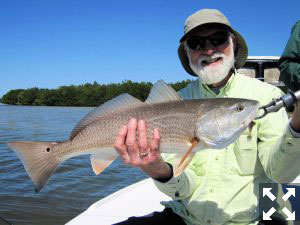
Reds should be a good option during March. Chuck Hempfling, from IL caught and released this one on a CAL jig with a shad tail.
Reds should be more active as the water warms and baitfish become more plentiful. Higher tides, as we head into spring, will allow them to spend more time feeding in shallow water. Look for them over shallow grass, along mangrove shorelines, and around oyster bars when the tide is high. You should find them in potholes and along sand bars when the tide is low. I like the shallow flats of north Sarasota Bay for reds this month.
I like 1/16-ounce CAL jigs with shad tails and jerk worms to locate reds. Fly anglers should score with my Grassett Flats Minnow fly, fished on a 10’-12’ leader. When using a long leader be sure you are able to turn it over, otherwise you’ll need to shorten it until you can. The butt section should be at least 50% of the total length of the leader and stiff enough to transfer energy from your fly line to the leader.
You might also find reds around docks when the tide is low. Look for deep water under docks with a good tidal flow for the best action. A 1/8-ounce CAL jig with a shad tail or grub or a weighted fly fished on a clear intermediate sink tip fly line with a 6’ leader with should work well for dock fishing.
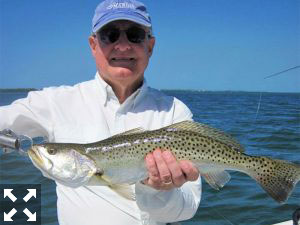
Trout fishing should be good during March. Alan Sugar, from MI, caught and released this one on an Ultra Hair Clouser fly.
You may find big trout in skinny water in many of the same places that you find reds. Blind cast seams where the grass meets sand or focus on the light colored bottom, in potholes on top of sand bars, where you may be able to sight fish them. FWC has also added trout over 20” to the emergency closure on the west coast of Florida through May 10, 2019. These fish are important to the health of our fishery.
You should also find trout plentiful on deep grass flats along with Spanish mackerel, blues, flounder or pompano. I like to make a series of drifts, casting ahead of the drift with CAL jigs with shad tails, DOA Deadly Combos or an Ultra Hair Clouser fly tied on a long shank hook and fished on a clear intermediate sink tip fly line to locate fish.
Also, look for birds, bait showering out of the water or boils on the surface that will indicate fish feeding below. When mackerel and blues are around, you may need to add 6” of 40# to 60# fluorocarbon or wire to your leader.
Topwater plugs and fly poppers also work well when blues and mackerel are around and may help locate them by attracting them from further away. Flounder may be found on sand or mud bottom areas on both shallow and deep grass flats or around docks. Pompano may skip on the surface when you drift or run past them, giving their location away. Fish deep grass flats with a mixture of grass and sand and a strong tidal flow for the best action.
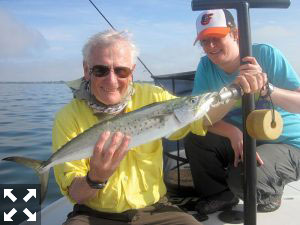
Spanish mackerel should be a good option during March. Tony Merlis, from NH, caught and released this one on an Utra Hair Clouser fly.
You may also find Spanish or king mackerel, false albacore (little tunny), cobia or tripletail in the coastal gulf this month. Look for diving or hovering terns to find Spanish mackerel or false albacore feeding on the surface. ¼-ounce CAL jigs with shad tails or jerk worms or topwater plugs should work well for spin anglers.
Fly anglers should score with small white flies, like my Grassett Snook Minnow or Ultra Hair Clousers fished on an intermediate sink tip fly line. Run crab trap lines at various depths to find tripletail or cobia around crab trap floats.
Fly anglers should score on tripletail with DOA Shrimp or lightly weighted flies with weed guards. Cobia may also be swimming on the surface as they migrate from south to north following warmer water and baitfish. DOA Baitbusters, Airheads, PT’s and large, wide profile flies, like Deceivers or EP flies would be good fly choices for cobia. In the absence of any fish on the surface, check out one of the many artificial reefs or natural hard bottom areas that may hold baitfish and predators. Drift over a structure and cast DOA Baitbusters or weighted flies on fast sinking fly lines to get deeper in the water column to catch them.
Conditions are usually good during March and fishing should heat up. Flats and night snook fishing are usually good options this month. I like to check the coastal gulf when conditions are good since you could find something really good happening there. Our natural resources are under constant pressure from red tides fueled by agricultural and residential runoff, freezes, increasing fishing pressure and habitat loss and degradation, please limit your kill, don’t kill your limit!
Capt. Rick Grassett’s Monthly Forecast for Feb. 2019
Trout and redfish should be good shallow water options in Sarasota Bay this month. You may also find trout along with blues, Spanish mackerel, pompano and flounder on deep grass flats. Look for sheepshead, flounder, reds and more around docks.
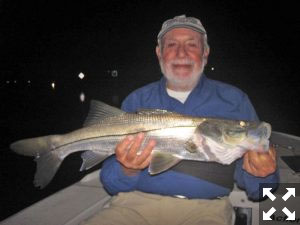
Martin Marlowe, from NY, with a snook caught and released on a Grassett Snook Minnow fly while fishing dock lights at night in the ICW.
Catch and release night snook fishing around lighted docks in the ICW may be a good option if it’s not too cold and Spanish and king mackerel and cobia may show up in the coastal gulf by the end of the month.
Snook and reds remain closed on the west coast of Florida. The Florida FWC has enacted a temporary modification of regulations for reds and snook, in the areas affected by the recent red tide. The area extends from Pasco County, south to the south bank of Gordon Pass in Collier County. Reds and snook are catch and release only in that zone until May 10, 2019. To view full details including exact boundaries click here.
Since snook are temperature sensitive, I won’t target them following strong fronts when water temperatures dip below 60 degrees. However, I have had some great night trips catching and releasing snook on flies in the ICW at night this time of year.
Since larger baitfish aren’t that plentiful this time of year, snook will gorge themselves on glass minnows and shrimp. Small white flies, like my Grassett Snook Minnow, DOA Shrimp (3’ or the newer 2-3/4”), DOA Tiny TerrorEyz or CAL Jigs with shad tails and jerk worms will all work well.
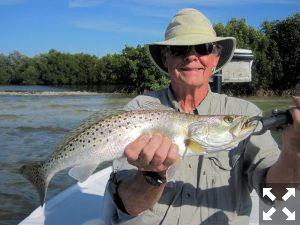
Keith McClintock, from Lake Forest, IL, with a nice trout both caught and released on a CAL jig with a shad tail while fishing Gasparilla Sound.
You may also find snook in rivers, creeks or canals this month. Fishing may be good in these areas on a blustery day when it isn’t fit to fish anywhere else. I like wider profile flies and lures in these areas due to the baitfish that may be found there.
Fly anglers should score with wide profile baitfish patterns, such as Lefty’s Deceiver, fished on a sink tip fly line. Spin anglers should do well with CAL jigs and 4” swim baits and jerk worms, DOA Baitbusters or suspending plugs. Fish the deep spots, usually on outside bends, for the best action.
You might find reds in potholes or along the edges of bars and shallow flats when the tide is low. As the tide rises, they will feed higher on shallow flats, particularly on sunny afternoons. I like 1/16-ounce CAL jigs with shad tails or jerk worms for reds in shallow water. If it is too shallow or grassy to fish an exposed hook, a Mustad or Owner weedless hook will allow you to fish plastic baits in these areas.
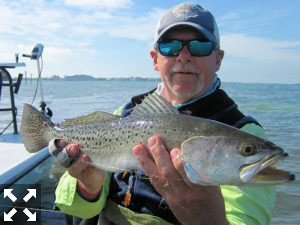
Mike Perez, from Sarasota, waded a Sarasota Bay sand bar with Capt. Rick Grassett and caught and released this big trout on a fly.
Fly anglers should score with lightly weighted flies, like Clousers or my Grassett Flats Minnow, with weed guards on floating lines with 10’-12’ leaders. You may also find big trout in skinny water in the same places you find reds. The same lures, flies and techniques that you use to target reds will work for big trout in those areas. I release all trout over 20” since they are usually females and I feel that they are important to the health of our trout fishery.
You’ll find trout on deep grass flats. I like flats that have a good mix of grass and sand and good tidal flow. Flats that are close to passes are often good choices since water temperatures may be warmer there. Following fronts, silted up water will cover deep grass flats close to passes, often affecting fishing in those areas.
Other good grass flats may be on points or around bars. I like to drift and cast ahead of my drift with CAL jigs and a variety of plastic tails, DOA Deadly Combos or weighted flies on sink tip fly lines to locate trout. Once you’ve located them you can shorten your drift or anchor on them.
In addition to trout, you may also find blues, Spanish mackerel, flounder or pompano, depending on water temperature and conditions, on deep grass flats. The technique to find them is the same as for trout, although there may be other clues. Pompano may “skip” on the surface when you drift or run past them giving their presence away. When that happens, set up a drift upwind of where you saw a pompano and cast ahead of your drift. Blues and Spanish mackerel may force bait out of the water or feed on the surface. You may need to add heavy fluorocarbon or wire when blues and mackerel are mixed with trout on deep grass flats.
Fishing docks is another good option this time of year, especially when the tide is low. You might find reds, sheepshead or flounder under docks. I like docks that are deep (3’ or more) and have a good tidal flow. Fish the end of long piers to find the deepest water. Also, look for big boats moored on docks or on boat lifts, which is also an indication of deeper water.
Older docks with lots of barnacle and oyster growth usually hold more baitfish and predators. I like CAL jigs with shad tails, grubs or jerk worms or weighted flies fished on sink tip fly lines when fishing docks. Be sure to let your jig or fly get down close to the bottom. Tipping a jig with small piece of fresh shrimp will up your odds for sheepshead. If you use too much it will ruin the action of your jig.
There may be some action in the coastal gulf by the end of the month with king and Spanish mackerel and cobia. When the water warms to the high 60’s to low 70’s, these fish will move into our area from the south as they migrate north. Look for Spanish mackerel on the surface or in passes. Cobia may be swimming on the surface, around buoys, channel markers and crab trap floats or over structure.
February can be a tough month to fish. With frequent fronts and cool water, fish aren’t always in an eating mood. If you’re able to pick good tides combined with favorable weather conditions, you should be successful. If you don’t have that luxury, you might do better by sleeping in and fishing later in the day when it’s warmer. Whatever you choose to do, please limit your kill, don’t kill your limit!
Capt. Rick Grassett’s Monthly Forecast for Jan. 2019
You may find reds and big trout concentrated in potholes of Sarasota Bay in January. Action with trout, blues, Spanish mackerel, pompano and more on deep grass flats can be good depending on conditions. There should also be good catch and release snook action in rivers, creeks, and canals this month, although fishing docks for snook and other species is also a good option. It may be worth checking the coastal gulf for tripletail, cobia, false albacore (little tunny) and more when it’s warm.
Snook and reds remain closed on the west coast of Florida. The Florida FWC has enacted a temporary modification of regulations for reds and snook, in the areas affected by the recent red tide. The area extends from Pasco County, south to the south bank of Gordon Pass in Collier County. Reds and snook are catch and release only in that zone until May 10, 2019. Full details including exact boundaries can be found by clicking here.
Snook are very temperature sensitive, so I won’t target them if the water temperature dips below 60 degrees. However, fishing lighted docks in the ICW at night with lures and flies can be very good in January. Small white flies, like my Grassett Snook Minnow, Gurglers and shrimp fly patterns will work well for fly anglers. Spin anglers should score with CAL jigs with shad tails or 4” jerk worms, DOA Tiny TerrorEyz and DOA 2-3/4” & 3” Shrimp Fish peak tidal flows for the best action.
You should also find snook in rivers, creeks and canals this month. Fish deeper water in outside bends to locate snook where you may catch them with CAL jigs and shad tails or jerk worms, DOA Baitbusters or diving/suspending plugs. You may also find reds, juvenile tarpon and even largemouth bass in the same areas depending on salinity.
Reds should be a good option this month. You’ll find them concentrated in potholes when the tide is low. Fly anglers should score with lightly weighted flies fished on a 10’-12’ leader with a floating fly line. Reds feed on crustaceans this time of the year, so crab and shrimp fly patterns should work well. They may tail on shallow grass flats of Gasparilla Sound and lower Tampa Bay when the tide is low.
You’ll need weedless rigged plastic baits or flies with weed guards to target tailing reds. A CAL shad tail on a weedless hook or a DOA shrimp rigged weedless and fished backwards are a couple of my favorite lures for tailing reds. The DOA Crab also fishes very well in shallow water and can be deadly on reds in potholes or tailing in shallow grass.
You may also find reds around docks, along with snook, sheepshead, flounder and more. Little Sarasota Bay has numerous oyster bars and docks that often hold reds in January.
Work CAL jigs slowly along the bottom for the best action. Sheepshead feed more with their nose, so if you can’t get them to eat your jig, try tipping it with a small piece of fresh shrimp. Too large of a shrimp tip on your jig will ruin the action.
You’re likely to find big trout in many of the same areas that you find reds. The same lures, flies and techniques that are used for reds will also work for big trout.
You’ll also find trout on deep grass flats in January along with blues, Spanish mackerel, pompano, flounder and more. I like to drift and cast ahead of my drift with CAL jigs and a variety of plastic tails and DOA Deadly Combos. Since trout can sometimes hold very tight to a particular spot or area, try to cover as much water as possible to find them.
Once you’ve located fish you can shorten your drift or anchor on them. A GPS can be useful for this type of fishing since the breadcrumb trail will allow you to duplicate your drift. A drift anchor will slow your drift so you can fish it more thoroughly or make it easier for fly anglers to move their fly.
My favorite deep grass flats, have a good mix of grass and sand with a strong tidal flow. Even though there may not be much happening in the coastal gulf this month in the way of sight fishing it may be worth a look when it is warm. Migratory species such as king and Spanish mackerel, cobia and tripletail probably have moved further south, however they could reappear during warm-ups. Also look for false albacore (little tunny) when it’s warm since they may move from offshore to inshore depending on where baitfish are located.
January can be one of the toughest months of the year to fish. However if you are able to choose when to fish based on tides and weather, it can be good. Action is usually good as weather fronts approach. Following fronts, fishing may be tough for a couple of days so afternoons may fish better at that time. I’ll let the stage of the tide determine where to look for fish. When the tide is low, look for reds tailing on shallow grass or reds, trout and more in potholes or around docks.
Look for reds or big trout cruising on shallow grass flats on sunny afternoons when the tide is high. Our natural resources are under constant pressure from red tides fueled by agricultural and residential runoff, freezes, increasing fishing pressure and habitat loss and degradation, please limit your kill, don’t kill your limit!
Capt. Rick Grassett’s Monthly Forecast for Dec. 2018
You may find reds along with big trout concentrated in potholes, along with the edges of bars or tailing on shallow grass flats on negative low tides this month. This is a good month for catch and release snook action around lighted docks in the ICW. Some lights will also have trout and reds making it possible to get a dock “slam”. There may also be good action in the coastal gulf with false albacore (little tunny), Spanish mackerel and tripletail, depending on conditions.
Snook and reds remain closed on the west coast of Florida. The Florida FWC has enacted a temporary modification of regulations for reds and snook, in the areas affected by the recent red tide. The area extends from Pasco County, south to the south bank of Gordon Pass in Collier County. Reds and snook are catch and release only in that zone until May 10, 2019. Full details including exact boundaries can be found at www.myfwc.com
However, catch and release snook fishing around lighted docks can be good this month unless it gets too cool. I won’t target snook following a strong cold front or if the water dips below 60 degrees, since they may be stressed at that time. However, it can be very good in December under normal conditions.
Larger baitfish will thin out and snook will gorge themselves on glass minnows and small shrimp in the ICW at night. I like docks that have a good tidal flow and deep water under them. CAL jigs with shad tails and jerk worms, DOA Tiny TerrorEyz and DOA Shrimp are my favorite lures for snook at night. Fly anglers should do well with sink tip fly lines and small white flies. Fish peak tidal flows for the fastest action.
You might find reds in potholes or along the edges of flats and bars on negative low tides. They may also tail on shallow grass when the tide is low. Weedless rigged CAL shad tails and jerk worms, DOA Shrimp and lightly weighted flies with weed guards will work well in that situation. As the tide rises, reds will spread out and feed on shallow flats. You may also find them around docks this month. I usually let the stage of the tide tell me where to look for reds.
You may also find big trout in skinny water this month in many of the same areas where you find reds. The same lures and techniques that I use for reds will also work for trout in the same areas. I release all big trout (over 20”) since they are usually females and I feel it is important that they are left in the water as breeders. You should also find trout on deep grass flats this month along with blues, flounder or pompano. Blues may sometimes feed on the surface, so bird activity may give their presence away.
Pompano may skip when you drift or run past them and when that happens, circle back upwind and drift through the area casting ahead of your drift. Flounder prefer a mix of sand and grass, particularly in potholes or on the edges of bars. I like to drift and cast ahead of my drift with CAL jigs and a variety of plastic tails or DOA Deadly Combos.
Fly anglers should score with sink tip fly lines and weighted flies, like Clousers or my Grassett Deep Flats Bunny fly, which behaves like a jig with a shad tail. I like the shallow flats of the south shore of Tampa Bay and Gasparilla Sound for reds and trout and deep grass flats that are close to passes, on points and along sand bars for trout, blues, flounder and pompano in December.
There should still be good action in the coastal gulf with Spanish mackerel, blues, false albacore, and tripletail. Rough or cold water later in the month may slow the action and move fish south or offshore. Look for terns either diving or hovering low over the surface of the water to find albies, blues and mackerel feeding on the surface. Once you’ve found them, cast topwater plugs or CAL jigs with shad tails to catch them.
Fly anglers should score with glass minnow fly patterns, poppers or Crease flies. Sometimes topwater plugs or fly poppers will draw fish to the surface, especially over structure. You’ll need to add wire or heavy fluorocarbon to your leader when blues and mackerel are around.
Look for tripletail around crab trap floats or channel markers. Once you’ve located a fish, work back into the wind or current with an electric trolling motor to get into casting range and cast a DOA shrimp, a weedless-rigged CAL shad tail or lightly weighted fly with a weed guard to them. Try to make your first shot count since they are much tougher to catch once they know you’re there.
There will be lots of options in December, although the weather becomes more of a factor. When fishing flats, I usually let conditions and the stage of the tide determine when, where and what I will target. I like to fish the coastal gulf for false albacore and tripletail whenever conditions are good. Our natural resources are under constant pressure from red tides fueled by agricultural and residential runoff, freezes, increasing fishing pressure and habitat loss and degradation, please limit your kill, don’t kill your limit!
Capt. Rick Grassett’s Monthly Forecast for Nov. 2018
As this is being written, the red tide outbreak in our area has improved significantly. Latest counts show very little to no red tide in Sarasota and Manatee Counties in the coastal gulf and inshore waters.
You may find blues, Spanish mackerel and pompano mixed with trout on deep grass flats. You should also find larger trout in skinny water along with reds. Snook will stage around bars and on shallow flats as they make their move towards winter areas. Action in the coastal gulf with false albacore, tripletail, Spanish mackerel, blues and more should explode!
Remember that snook and reds are off limits on portions of the west coast now. The Florida FWC has enacted a temporary modification of regulations for reds and snook, in the areas affected by the recent red tide. The area extends from Pasco County, south to the south bank of Gordon Pass in Collier County.
Reds and snook are catch and release only in that zone until May 10, 2019. I applaud them for taking this action to protect our fishery. Full details including exact boundaries can be found at www.myfwc.com/news/news-releases/2018/september/26/comm-red-tide/.
You should find snook staging around docks and bridges in the ICW and along sand bars and in potholes on shallow flats. They may be along mangrove shorelines when the tide is high. I like CAL jigs with 3” and 4” shad tails, surface walking top water lures like the new DOA “PT” and DOA Baitbusters in shallow water for snook.
CAL jigs with shad tails or jerk worms, DOA TerrorEyz, DOA Shrimp and small white flies, like my Grassett Snook Minnow, will work well around dock and bridge fender lights. Fish the strongest tides for the best action. I like the ICW between Sarasota and Venice at night for snook in November.
Reds will spread out on shallow grass flats in November. You should find them along bars, in potholes or around docks. Look for them along mangrove shorelines when the tide is high, but they are just as likely to be roaming with mullet schools in shallow water.
CAL jigs with shad tails, grubs or jerk worms, and gold spoons should work well for reds in shallow water. Fly anglers may score with lightly weighted flies, such as Clousers, spoon flies or my Grassett Flats Minnow fly. I catch a lot more reds wading than from the deck of my boat, so keep a low profile.
You may also find big trout along with reds in shallow water this month. Although anglers may keep one trout over 20”, I release all trout over 20” since they are usually females that may be full of roe.
The same lures and flies that you use for snook and reds in shallow water will also work for trout. You’ll also find trout on deep grass flats in water from 3’ to 7’ deep. I like to drift and cast quartering ahead of my drift with CAL jigs, DOA Deadly Combos or weighted flies on sink tip fly lines to locate trout. In addition to making a series of drifts to find fish, look for baitfish on the surface or birds to find them.
You may also find blues, Spanish mackerel, flounder or pompano on deep grass flats this month. The techniques to find them is the same as for trout, although blues and Spanish mackerel may feed on the surface making them easier to find. Likewise with pompano, that may skip on the surface when you run or drift past them. When that happens, circle back upwind and drift back through the area, casting ahead of your drift.
I like a 1/16-ounce chartreuse CAL jig head with a gold grub for pompano. You’ll need to add wire or heavy fluorocarbon when toothy fish are around to keep them from biting you off. You may find flounder on a mixture of grass and sand, particularly on the edges of bars or in potholes.
There should be good action in the coastal gulf with false albacore (little tunny), Spanish and king mackerel, blues, tripletail or cobia. Look for Spanish mackerel, blues or false albacore feeding on the surface to find them. Diving terns or terns hovering just above the surface of the water topwaterng fast will give their presence away if they aren’t on top.
CAL jigs with shad tails and jerk worms and topwater plugs will work well. Fly anglers should score with small white flies, Ultra Hair Clousers, poppers or Crease flies. Look for tripletail around crab trap floats and cast DOA Shrimp, CAL jigs with shad tails or DOA TerrorEyz to them. Cobia may also be found around crab trap floats, swimming on the surface or over structure.
They will require medium-heavy spinning tackle or at least a 9-weight fly rod. Larger baits like DOA Baitbusters, CAL jigs with 5½” jerk worms or the DOA Snake should work well for cobia on spinning tackle. Fly anglers should score with wide profile baitfish patterns.
This a great month for fishing the flats or the coastal gulf. Since the action in the coastal gulf is seasonal and will end when it gets cooler, I like to fish there when conditions allow it. However, if that’s not for you or if conditions won’t allow it, there will be plenty of action for a variety of fish on shallow and deep grass flats of Sarasota Bay. Our natural resources are under constant pressure from red tides fueled by agricultural and residential runoff, freezes, increasing fishing pressure and habitat loss and degradation, please limit your kill, don’t kill your limit!
Capt. Rick Grassett’s Monthly Forecast for Oct. 2018
Most of you are probably aware that our area has been heavily impacted by a severe and extended red tide. However, red tide doesn’t usually blanket an entire area, it is often patchy and can change from day to day depending on wind direction and tidal flow. There are some areas that are unaffected and fish may concentrate in those areas, so the key to good fishing now is finding clean water that is unaffected by red tide.
Red tide doesn’t do well in fresh water, so areas where salinity is diluted by fresh water such as creek and river mouths, may be a good option. As this is being written, the Florida FWC has enacted a temporary modification of regulations for reds and snook, in the areas affected by the recent red tide. The area extends from Pasco County, south to the south bank of Gordon Pass in Collier County. Reds and snook will be catch and release only until May 10, 2019. I applaud them for taking this action to protect our fishery. Full details including exact boundaries can be found at http://myfwc.com/news/news-releases/2018/september/26/comm-red-tide/ .
That being said, areas of Tampa Bay, Charlotte Harbor and the coastal Gulf of Mexico should turn on this month. Schools of reds will begin to break up and scatter on shallow flats. There should also be good action with snook and big trout in shallow water. Snook will gorge themselves at night around lighted docks in the ICW. There should also be good action in the coastal gulf with Spanish mackerel, false albacore (little tunny), tripletail and cobia. You might also still find tarpon anywhere from upper Charlotte Harbor and Tampa Bay to along the beaches.
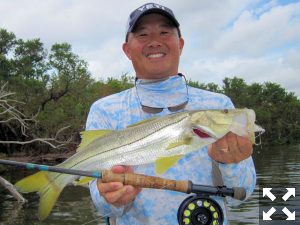
Jon Yenari, from Sarasota, caught and released this snook on a fly while fishing Tampa Bay with Capt. Rick Grassett in a previous October.
Snook will move from passes and the surf as water temperature cools and days get shorter. They will stage around docks and bridges in the ICW and along sand bars, potholes and along mangrove shorelines.
They may blow up on top water plugs or fly poppers in shallow water early or late in the day. CAL jigs with shad tails and jerk worms or DOA Shrimp should work well around docks and bridges and on shallow flats.
The 4” CAL shad tail should work very well on the flats since larger baits will be prevalent there. I like larger flies, like Lefty’s Deceiver and EP flies, for snook on the flats for the same reason. Fly anglers should also score with small white flies or Gurglers around lighted docks and bridge fenders. Fish peak tidal flows for the best action.
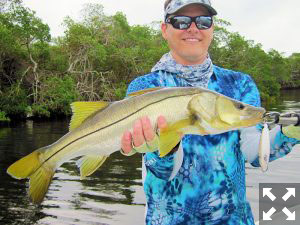
October should be a good month for snook on the flats. Kyle Ruffing, from Sarasota, caught and released this one on a top water plug while fishing Tampa Bay with Capt. Rick Grassett in a previous October.
Tarpon will still be an option this month. I find them in upper Charlotte Harbor this time of year. Look for them feeding in ladyfish schools or rolling in deep water to find them. DOA Baitbusters and Swimming Mullet are my top producing lures for large tarpon. Fly anglers should score with many of the same flies that work for sight casting to them along the beaches. I use 12-wt fly tackle with a floating or clear intermediate sink tip line for large tarpon. You’ll also find juvenile tarpon from 10 to 30-pounds in many creeks and canals of the Peace or Myakka Rivers.
Spin anglers should score with DOA Shrimp or TerrorEyz on snook tackle. Fly anglers can handle the smaller fish on 8 or 9-wt fly rods with fast sinking fly lines and a scaled down version of any fly that large tarpon will eat. I’ve also found tarpon feeding heavily in the coastal gulf in October. They are usually scattered over a broad area, feeding and “blowing up” in bait schools. This “reverse migration” may only last for a few days but it can be really good!
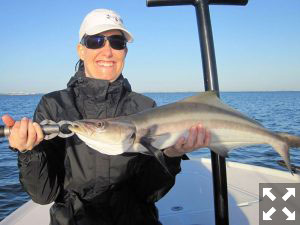
Tatiana Migliaretti, from Switzerland, caught and released this cobia in Sarasota Bay on a CAL jig with a shad tail while fishing with Capt. Rick Grassett in a previous October.
Big schools of reds that are more common in August and September will break up into smaller schools, singles and doubles by the end of the month.
As water cools and baitfish school up, reds will feed in shallow water. I like to pole my flats skiff to hunt for reds in shallow water.
Focus on baitfish or mullet schools to find reds. CAL jigs with shad tails, including the 4” CAL shad tail, DOA Baitbusters or Airheads are some of my favorite lures to locate reds with. If the tide is very low, weedless-rigged CAL shad tails and Airheads or DOA Shrimp rigged backwards will work well in the thick turtle grass.
Once I’ve located fish, wading is often the best way to approach them when fly fishing. I like a long leader (12’) on a floating fly line with a lightly weighted fly with a weed guard, like my Grassett Flats Minnow. When you have good sunlight, you may be able to sight fish them on light colored bottom, like sandbars or potholes.
You’ll also find big trout in many of the same areas in shallow water. I would approach locating big trout the same way as reds. Focus on baitfish or mullet schools to find them and use the same lures and flies to catch them. Some of the best action that I’ve experienced with big trout was at first light with big trout feeding in baitfish schools in very shallow water.
You’ll find trout of all sizes on deep grass flats. Wherever there are small trout, there may be a few “gators” around since big trout will eat small ones. Mixed with trout there should also be blues, Spanish mackerel or pompano.
In addition to focusing on bait and birds, I like to drift and cast ahead of the drift with CAL jigs and shad tails or DOA Deadly Combos or a lightly weighted fly on a sink tip fly line to find fish. When toothy fish are around add 6”of heavy fluorocarbon (60-lb) or wire to prevent cut offs.
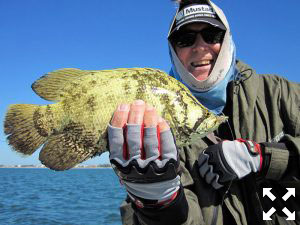
Ken Babineau caught and released this one on a fly in Sarasota while fishing with Capt. Rick Grassett in a previous October.
You may find tripletail or cobia around buoys, crab trap floats or channel markers in inside waters or the coastal gulf. A DOA Shrimp or CAL jig with a shad tail will work well for tripletail. Fly anglers should score with lightly weighted flies with a weed guard. A DOA Baitbuster, 4” CAL shad or Airhead on 20 to 30-pound class spinning tackle or a wide profile tarpon fly on a minimum of 9-weight fly tackle will get the job done with cobia.
Look for Spanish and king mackerel or false albacore in the coastal gulf. I look for diving terns or “breaking” fish to find them. Once you’ve located feeding fish, a CAL jig with a shad tail or jerk worm or a size specific top water plug will work well for spin anglers. Fly anglers should score with olive, chartreuse or white flies, poppers and Crease flies. You’ll need wire or heavy fluorocarbon when mackerel are in the mix.
You may also find a few kings around the edges of feeding frenzies. I don’t usually target kings, but I will catch a few when fishing breaking mackerel or albies. You can also look for tripletail or cobia around crab trap floats, buoys or channel markers while searching for mackerel or albies in the coastal gulf.
October is one of my favorite months. It’s nice to do something different, so I like to fish the coastal gulf for mackerel, false albacore, tripletail and cobia when conditions are good. There should also be good action on shallow flats with reds, trout and snook or tarpon of all sizes in upper Charlotte Harbor. Night snook fishing in the ICW heats up as the water cools down. Our natural resources are constantly under pressure from freezes, red tides fueled by agricultural and residential runoff, increasing fishing pressure and habitat loss and degradation, please limit your kill, don’t kill your limit!
Capt. Rick Grassett’s Monthly Forecast for Sept. 2018
As most of you already know, we are having a severe and extensive red tide as this is being written, although it is showing signs of improvement in some areas. Fortunately, the Florida FWC has enacted a temporary modification of regulations for reds and snook, in the areas affected by the recent red tide.

September is usually a good month to fish the flats. Keith McClintock had good action with trout with Capt. Rick Grassett in a previous September.
The area extends from a line in Manatee County from Emerson Pt west to Bean Pt and continuing west to the Hillsborough County line, south to the south bank of Gordon Pass in Collier County. Reds and snook will be catch and release only until at least Oct 12, 2018, to allow a stock assessment to be completed before determining if the action will be rescinded or extended. Full details including exact boundaries can be found at www.myfwc.com. Personally, I wish spotted sea trout would have also been included, especially breeders over 20”, but I applaud them for taking this action to protect our fishery.
That being said, September is usually one of my favorite months, although this is not a normal September. Reds should be schooling on shallow grass flats and you also might find big trout there at first light. Baitfish along beaches will attract Spanish mackerel, false albacore (little tunny), sharks, tarpon and more. You should find snook around docks and bridges in the ICW.
There should also be tarpon around bridges at night and in areas of Tampa Bay and Charlotte Harbor. Juvenile tarpon from 10 to 30-pounds should be a good option in creeks and canals. All of this depends on how quickly the red tide clears up.
The key to good fishing this September will be finding clean water that is unaffected by red tide. Right now that would be the south shore of Tampa Bay, areas of Little Sarasota Bay and upper Charlotte Harbor. Red tide doesn’t do well in fresh water, so areas, where fresh water is flowing out of creeks and rivers, should be a good option.
Tarpon will still be a good option this month. There may still be a few singles, doubles and small schools in the coastal gulf and if you’ve got the patience to wait them out it can be good. Many have moved to inside waters this month, so you’ll find them around bridges, over deep grass flats or deeper areas. When tarpon move into these areas, they are in a feeding mode. After a long migration and with their spawning duties completed, they need to rest and eat to restore themselves. Ladyfish will feed in glass minnow schools and tarpon will gorge themselves on ladyfish. I have also seen tarpon, “ball” glass minnows into tight schools, and eat them by the bucket full! DOA Baitbusters, TerrorEyz, and DOA Shrimp are my favorite tarpon lure this time of year. Fly anglers should score with wide profile patterns, such as Lefty’s Deceiver or EP flies. Small flies, like my Grassett Snook Minnow, tied on a 1/0 or 2/0 hook, are another good choice for tarpon that are feeding on glass minnows.
As mentioned above, Snook season will not reopen on Sept. 1st in the area described above that is affected by red tide. Personally, I will continue to ask that snook be released on my boat. They are a magnificent game fish that hits hard, runs strong and fights smart. If continuing to release them now means more and bigger snook later, I’m all for that. You should find snook this month around docks and bridges close to passes. They will also start making their move towards shallow flats where you might find them staging along sandbars or in potholes.
Surface walking topwater plugs or fly popper and Gurglers may draw some big strikes in shallow water early in the day. I often fish lighted docks and bridges for snook before dawn before moving to the flats after daylight. CAL jigs with shad tails and jerk worms, DOA Shrimp or small white flies, like my Grassett Snook Minnow, should all work well. The same lures and flies that work at night will be good for fishing the surf, too.
Same with reds, they will be catch and release until at least Oct 12. Beyond that, I will continue to ask my clients to also release reds. We had a problem with reds before the red tide and now they need even more help to recover. Reds are usually in large schools in September. You may find them in shallow water when the tide is high or along the edges of flats when the tide is low. Look for wakes, some as big as boat wakes, or “pushes” to locate them. If it is calm, a school of reds may look like a nervous patch of water or if there’s a ripple on the surface, the school may appear as a slick patch of water. Once you’ve located them, try to get in front of them and work around the edges of the school to avoid spooking the whole school. Surface walking topwater plugs, shallow running DOA Baitbusters, CAL 4” shad tails and DOA Airheads (I like to clip the tail so it works like a buzz bait) should work well for spin anglers.
Fly anglers should score with fly poppers, Gurglers and wide profile baitfish fly patterns. I like to be as quiet as possible in the shallow water, using a push pole to move my boat. Electric trolling motors can be used sparingly, but varying the speed or running at faster speeds will often spook a school. It is great to find a big school of reds but remember, if you spook 1 fish you may spook the whole school. Running an outboard may make fish show themselves, but in the long run, it will make them harder to catch. I sometimes also find big jacks and blues mixed with schools of big reds in shallow water. Not a bad problem!
Trout fishing should also be good this month. Look for big trout in skinny water in many of the same places that you find reds this month. They will be most active in low light, either first thing in the morning or at dusk, particularly if we’ve had an afternoon shower. Cloud cover in the afternoon will also reduce heating of shallow flats, which usually makes fish more active. The same lures and flies that you use for reds will work well for big trout in shallow water. I release all trout over 20” on my boat since they are usually females, capable of spawning thousands of other trout.
You may also find trout mixed with blues, pompano, Spanish mackerel, flounder and more on deep grass flats of Sarasota Bay. I like to drift and cast ahead of my drift with DOA Deadly Combos or CAL jigs with shad tails or jerk worms. Fly anglers should do well with an Ultra Hair Clouser fly fished on a clear intermediate sink tip. In addition to making a series of drifts to find fish, focus on bait schools, breaking fish or diving birds to find fish. You may find tripletail on buoys, crab trap floats or channel markers in Sarasota Bay this month. A DOA shrimp, CAL jig or a lightly weighted fly with a weed guard should get the job done.
You should also find tripletail along with cobia, false albacore (little tunny), king and Spanish mackerel in the coastal gulf this month. Look for surface activity to find the mackerel and albies and cast small white flies or CAL jigs with shad tails to them. I don’t usually target kings but will occasionally catch one around the edges of a feeding frenzy. Look for feeding frenzies that begin with ladyfish feeding in glass minnow schools and may end with everything else, including sharks or tarpon, joining the fray. Remember to “match the hatch” to be successful. You’ll need to add wire to your leader when toothy fish are around.
While you are looking for mackerel and albies in the coastal gulf, you can look for tripletail and cobia. However since stone crab traps haven’t hit the water yet this season, there are fewer places for them to be. In addition to abandoned crab trap floats, check channel markers, buoys and any floating debris. Artificial reefs are another good area to check. A DOA Baitbuster, DOA Airhead, 4” CAL shad tail or a wide profile fly should be good choices for cobia. Most tarpon flies also work well for cobia.
There are lots of options this month, but the key is usually to fish early or late for the best chance at success. An early start for snook or tarpon around lighted docks or bridges and then on to the flats for reds, trout and more is a good plan. There should also be good action in the coastal gulf for a variety of species. I usually tarpon fish as long as I can, wherever I find them! Our natural resources are constantly under pressure from freezes, red tides fueled by agricultural and residential runoff, increasing fishing pressure and habitat loss and degradation due to development, please limit your kill, don’t kill your limit!
